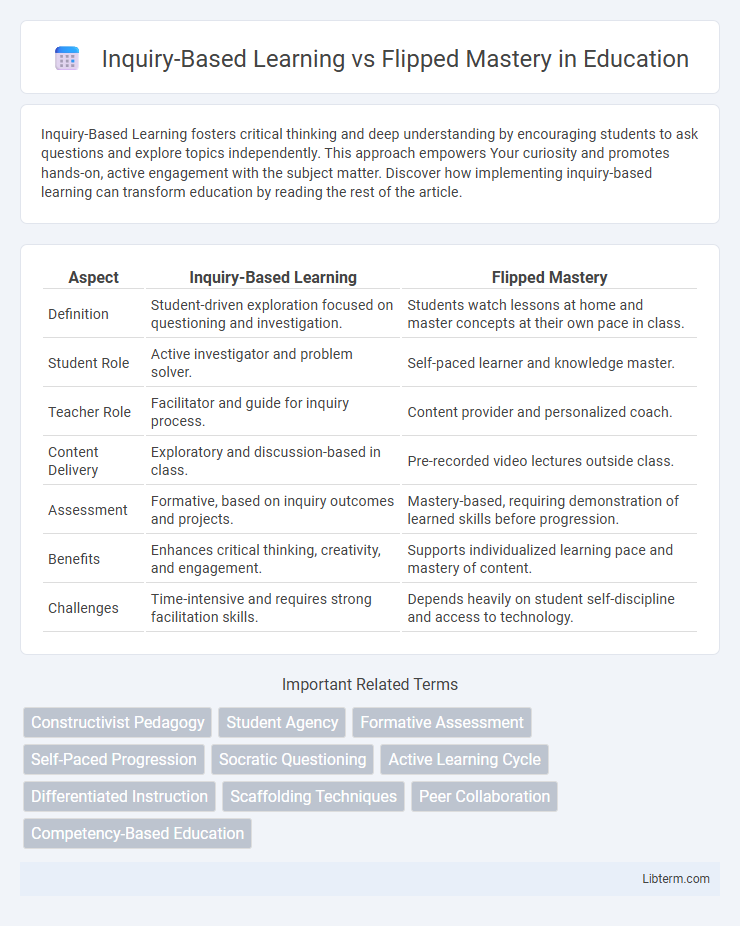Inquiry-Based Learning fosters critical thinking and deep understanding by encouraging students to ask questions and explore topics independently. This approach empowers Your curiosity and promotes hands-on, active engagement with the subject matter. Discover how implementing inquiry-based learning can transform education by reading the rest of the article.
Table of Comparison
| Aspect | Inquiry-Based Learning | Flipped Mastery |
|---|---|---|
| Definition | Student-driven exploration focused on questioning and investigation. | Students watch lessons at home and master concepts at their own pace in class. |
| Student Role | Active investigator and problem solver. | Self-paced learner and knowledge master. |
| Teacher Role | Facilitator and guide for inquiry process. | Content provider and personalized coach. |
| Content Delivery | Exploratory and discussion-based in class. | Pre-recorded video lectures outside class. |
| Assessment | Formative, based on inquiry outcomes and projects. | Mastery-based, requiring demonstration of learned skills before progression. |
| Benefits | Enhances critical thinking, creativity, and engagement. | Supports individualized learning pace and mastery of content. |
| Challenges | Time-intensive and requires strong facilitation skills. | Depends heavily on student self-discipline and access to technology. |
Introduction to Inquiry-Based Learning and Flipped Mastery
Inquiry-Based Learning emphasizes student-driven exploration where learners actively investigate questions, construct knowledge, and develop critical thinking skills through hands-on experiences. Flipped Mastery reorganizes traditional classroom dynamics by assigning instructional content as homework and dedicating class time to personalized skill mastery, allowing students to progress at their own pace. Both models shift the teacher's role from knowledge transmitter to facilitator, fostering deeper engagement and individualized learning trajectories.
Core Principles of Inquiry-Based Learning
Inquiry-Based Learning centers on student-driven exploration where learners formulate questions and investigate problems to construct knowledge actively. It emphasizes critical thinking, curiosity, and the development of problem-solving skills through open-ended inquiry and real-world context engagement. Core principles include fostering learner autonomy, promoting collaborative learning environments, and integrating reflection to deepen understanding.
Fundamental Concepts of Flipped Mastery
Flipped Mastery centers on students progressing through fundamental concepts at their own pace, ensuring mastery before advancing to more complex topics. This approach leverages pre-recorded lessons and interactive assessments to reinforce understanding, allowing personalized learning paths. Mastery-based progression contrasts with Inquiry-Based Learning by emphasizing skill competence over exploratory discovery.
Comparing Learning Outcomes: Inquiry vs Flipped
Inquiry-Based Learning fosters critical thinking, problem-solving, and deep understanding by engaging students in exploring questions and constructing knowledge actively. Flipped Mastery emphasizes student-paced mastery of content through pre-class instructional materials and in-class application, resulting in personalized learning and higher content retention. Comparative studies indicate Inquiry-Based Learning enhances creativity and conceptual insights, while Flipped Mastery improves factual recall and skill proficiency, making each method effective depending on targeted learning outcomes.
Student Engagement: Inquiry-Based vs Flipped Mastery
Inquiry-Based Learning fosters active student engagement by encouraging exploration, critical thinking, and problem-solving within real-world contexts, resulting in deeper conceptual understanding and intrinsic motivation. Flipped Mastery emphasizes self-paced progression through pre-recorded lessons and targeted practice, allowing students to take ownership of their learning while teachers provide personalized support, which enhances engagement through mastery of content. Both methods promote active participation but differ in structure; inquiry-based relies on open-ended investigation, whereas flipped mastery focuses on mastery through sequential skill acquisition.
Teacher Roles in Each Approach
In Inquiry-Based Learning, teachers act primarily as facilitators who guide student exploration and encourage critical thinking by posing open-ended questions and supporting collaborative problem-solving. In contrast, Flipped Mastery shifts the teacher's role to that of a learning coach who provides personalized support, monitors individual progress through mastery checkpoints, and tailors instruction based on diagnostic assessments. Both approaches require adaptive teaching strategies, but Inquiry-Based Learning emphasizes fostering student autonomy while Flipped Mastery focuses on structured mastery of content.
Assessment Strategies: Inquiry-Based Learning and Flipped Mastery
Inquiry-Based Learning employs formative assessments emphasizing critical thinking and problem-solving through open-ended questions and student reflections to gauge understanding continuously. Flipped Mastery relies on mastery-based assessments, including quizzes and checkpoints completed after students engage with content independently, ensuring competency before advancing. Both strategies prioritize personalized feedback but differ in timing and structure, with inquiry assessments fostering exploration and flipped mastery ensuring skill acquisition through measurable milestones.
Technology Integration in Both Models
Inquiry-Based Learning leverages technology through digital research tools, interactive simulations, and collaborative platforms to enhance student exploration and critical thinking. Flipped Mastery integrates technology by providing video lectures, adaptive learning software, and online assessments that allow students to progress at their own pace. Both models utilize technology to personalize learning experiences and promote active student engagement, but Inquiry-Based Learning emphasizes discovery while Flipped Mastery focuses on mastery through structured content delivery.
Advantages and Challenges of Each Method
Inquiry-Based Learning fosters deep critical thinking and student engagement by encouraging exploration and questioning, but it may challenge educators with unpredictable classroom dynamics and require more preparation time. Flipped Mastery enables personalized pacing and efficient use of class time through pre-recorded lessons, though it depends heavily on student motivation and access to technology. Both methods enhance active learning but necessitate careful implementation to address their distinct limitations.
Choosing the Right Approach for Your Classroom
Inquiry-Based Learning fosters critical thinking by encouraging students to explore questions and problems through active investigation, ideal for classrooms aiming to boost curiosity and adaptability. Flipped Mastery emphasizes self-paced progression with students mastering content before applying it in class, making it suitable for environments with varied learning speeds and the need for personalized support. Selecting the right approach depends on your classroom's goals, student autonomy levels, and resource availability to optimize engagement and mastery.
Inquiry-Based Learning Infographic

 libterm.com
libterm.com